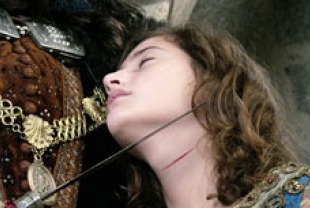Dr. Bruno Bettleheim argues that fairy tales make excellent intellectual, spiritual, and emotional tutors for children. Like Biblical parables, they create occasions for boys and girls to confront their inner selves. Through them children can wrestle with feelings of self-worth, sibling rivalry, oedipal dilemmas, and questions about the nature of right and wrong.
Bluebeard, written and directed by the controversial French director Catherine Breillat, is a lyrical and elegant film with two different parts based on Perrault's classic three-page fairy tale. The first part is set in the 1950s. Two little sisters go to a mysterious attic where they find a copy of the fairy tale about Bluebeard. The younger child, who seems to be the fearless one, reads the story aloud and definitely derives pleasure in scaring her older and more sensible sister. She is not put off by the wealthy monster who is rumored to have murdered all of his many wives.
The second strand of the film is set in the Renaissance. Two sisters who attend a convent school are kicked out by the Mother Superior after learning that their father died while trying to save a child. They arrive at home and find their mother distraught about their future since they have no dowry. The younger sister, Marie-Catherine (Lola Creton), goes to a gathering hosted by a rich man named Bluebeard who is looking for a new wife. She impresses him with her innocence and enthusiasm, and they are wed. Marie-Catherine is a smart beyond her years and proves herself to be a resilient heroine in the face of an odd relationship and imminent danger.
Bluebeard enables us to see that it is best to face our fears squarely and not to run away or try to evade them.
